The SSD Relapse: Understanding and Choosing the Best SSD
by Anand Lal Shimpi on August 30, 2009 12:00 AM EST- Posted in
- Storage
What's Wrong with Samsung?
The largest SSD maker in the world is Samsung. Samsung makes the drives offered by Apple in its entire MacBook/MacBook Pro lineup. Samsung makes the drives you get if you order a Lenovo X300. In fact, if you're buying any major OEM system with an SSD in it, Samsung makes that drive.
It's just too bad that those drives aren’t very good.
This is the 4KB random write performance of Samsung's latest SSD, based on the RBB controller:
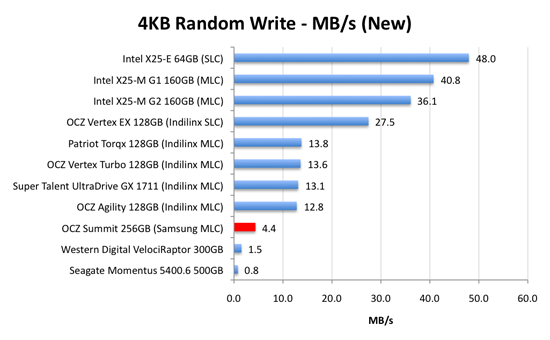
4.4MB/s. That's 3x the speed of a VelociRaptor, but 1/3 the speed of a cheaper Indilinx drive.
Speedy, but not earth shattering. Now let's look at performance once every LBA has been written to. This is the worst case scenario performance we've been testing for the past year:
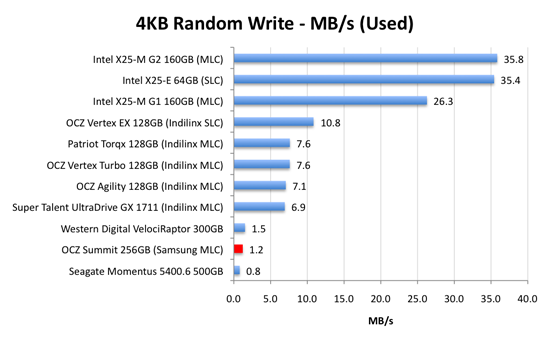
...and now we're down to mechanical hard drive speeds
Holycrapwtfbbq? Terrible.
Now to be fair to Samsung, this isn’t JMicron-terrible performance. It’s just not worth the money performance.
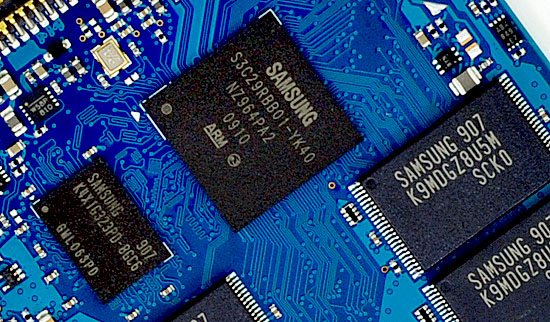
The Samsung RBB based SSDs are rebranded by at least two manufacturers: OCZ and Corsair.
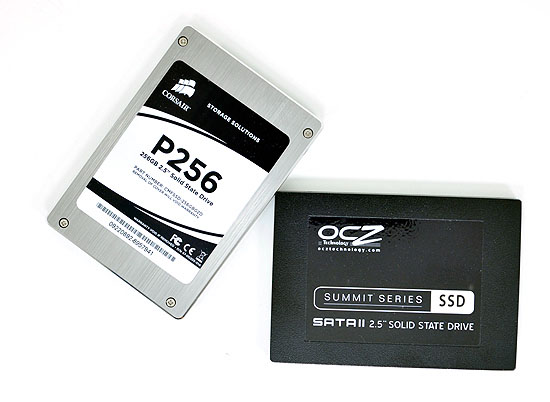
The OCZ Summit and the Corsair P256 both use the Samsung RBB platform.
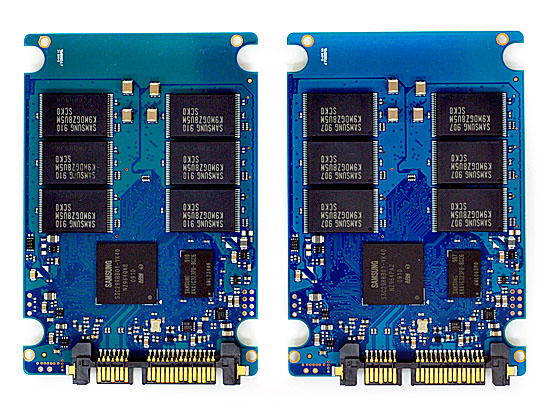
The Corsair and OCZ Samsung RBB drives.
The drive most OEMs are now shipping is an even older, lower performing Samsung SSD based on an older controller.
I talked to some of the vendors who ship Samsung RBB based SSDs and got some sales data. They simply can’t give these drives away. The Indilinx based drives outsell those based on the Samsung RBB controller by over 40:1. If end users are smart enough to choose Indilinx and Intel, why aren't companies like Apple and Lenovo?
Don't ever opt for the SSD upgrade from any of these OEMs if you've got the option of buying your own Indilinx or Intel drive and swapping it in there. If you don't know how, post in our forums; someone will help you out.
Samsung realized it had an issue with its used-state performance and was actually the first to introduce background garbage collection; official TRIM support will be coming later. Great right? Not exactly.
There’s currently no way for an end user to flash the firmware on any of these Samsung drives. To make matters worse, there’s no way for companies like OCZ or Corsair to upgrade the firmware on these drives either. If you want a new firmware on the drive, it has to go back to Samsung. I can’t even begin to point out how ridiculous this is.
If you’re lucky enough to get one of the Samsung drives with background garbage collection, then the performance drop I talked about above doesn’t really matter. How can you tell? Open up Device Manager, go to your SSD properties, then details, then select Hardware Ids from the dropdown. Your firmware version will be listed at the end of your hardware id string:
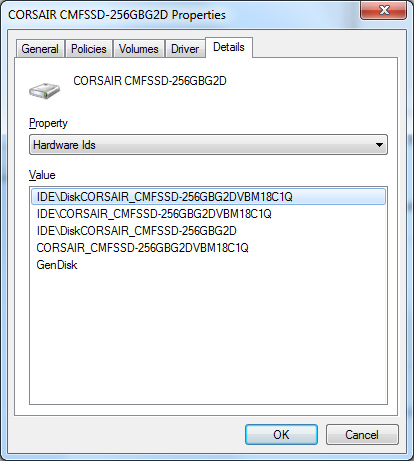
Version 1801Q doesn’t support BGC. Version 18C1Q (or later) does.
How can you ensure you get a model with the right firmware revision? Pick a religion and start praying, because that’s the best you can do.
Now the good news. When brand new, the Samsung drives actually boast competitive sequential write, sequential read and random write speeds.
These drives are also highly compatible and very well tested. For all of the major OEMs to use them they have to be. It’s their random write performance that’s most disappointing. TRIM support is coming later this year and it will help keep the drives performing fresh, but even then they are still slower than the Indilinx alternatives.
There’s no wiper tool and there’s currently no method to deploy end-user flashable firmware updates. Even with TRIM coming down the road, the Samsung drives just don’t make sense.










295 Comments
View All Comments
Anand Lal Shimpi - Monday, August 31, 2009 - link
wow I misspelled my own name :) Time to sleep for real this time :)Take care,
Anand
IntelUser2000 - Monday, August 31, 2009 - link
Looking at pure max TDP and idle power numbers and concluding the power consumption based on those figures are wrong.Look here: http://www.anandtech.com/cpuchipsets...px?i=3403&a...">http://www.anandtech.com/cpuchipsets...px?i=3403&a...
Modern drives quickly reach idle even between times where the user don't even know and at "load". Faster drives will reach lower average power because it'll work faster to get to idle. This is why initial battery life tests showed X25-M with much higher active/idle power figures got better battery life than Samsungs with less active/idle power.
Max power is important, but unless you are running that app 24/7 its not real at all, especially the max power benchmarks are designed to reach close to TDP as possible.
Anand Lal Shimpi - Monday, August 31, 2009 - link
I agree, it's more than just max power consumption. I tried to point that out with the last paragraph on the page:"As I alluded to before, the much higher performance of these drives than a traditional hard drive means that they spend much more time at an idle power state. The Seagate Momentus 5400.6 has roughly the same power characteristics of these two drives, but they outperform the Seagate by a factor of at least 16x. In other words, a good SSD delivers an order of magnitude better performance per watt than even a very efficient hard drive."
I didn't have time to run through some notebook tests to look at impact on battery life but it's something I plan to do in the future.
Take care,
Anand
IntelUser2000 - Monday, August 31, 2009 - link
Thanks, people pay too much attention to just the max TDP and idle power alone. Properly done, no real apps should ever reach max TDP for 100% of the duration its running at.cristis - Monday, August 31, 2009 - link
page 6: "So we’re at approximately 36 days before I exhaust one out of my ~10,000 write cycles. Multiply that out and it would take 36,000 days" --- wait, isn't that 360,000 days = 986 years?Anand Lal Shimpi - Monday, August 31, 2009 - link
woops, you're right :) Either way your flash will give out in about 10 years and perfectly wear leveled drives with no write amplification aren't possible regardless.Take care,
Anand
cdillon - Monday, August 31, 2009 - link
I gather that you're saying it'll give out after 10 years because a flash cell will lose its stored charge after about 10 years, not because the write-life will be surpassed after 10 years, which doesn't seem to be the case. The 10-year charge life doesn't mean they become useless after 10 years, just that you need to refresh the data before the charge is lost. This makes flash less useful for data archival purposes, but for regular use, who doesn't re-format their system (and thus re-write 100% of the data) at least once every 10 years? :-)Zheos - Monday, August 31, 2009 - link
"This makes flash less useful for data archival purposes, but for regular use, who doesn't re-format their system (and thus re-write 100% of the data) at least once every 10 years? :-)"I would like an input on that too, cuz thats a bit confusing.
GourdFreeMan - Tuesday, September 1, 2009 - link
Thermal energy (i.e. heat) allows the electrons trapped in the floating gate to overcome the potential well and escape, causing zeros (represented by a larger concentration of electrons in the floating gate) to eventually become ones (represented by a smaller concentration of electrons in the floating gate). Most SLC flash is rated at about 10 years of data retention at either 20C (68F) or 25C (77F). What Anand doesn't mention is that as a rule of thumb for every 9 degrees C (~16F) that the temperature is raised above that point, data retention lifespan is halved. (This rule of thumb only holds for human habitable temperatures... the exact relation is governed by the Arrhenius equation.)Wear leveling and error correction codes can be employed to mitigate this problem, which only gets worse as you try to store more bits per cell or use a smaller lithography process without changing materials or design.
Zheos - Tuesday, September 1, 2009 - link
Thank you GourdFreeMan for the additional input,But, if we format like every year or so , doesnt the countdown on data retention restart from 0 ? or after ~10 year (seems too be less if like you said temperature affect it) the SSD will not only fail at times but become unusable ? Or if we come to that point a format/reinstall would resolve the problem ?
I dont care about losing data stored after 10 years, what i do care is if the drive become ASSURELY unsusable after 10 year maximum. For drives that comes at a premium price, i don't like this if its the case.